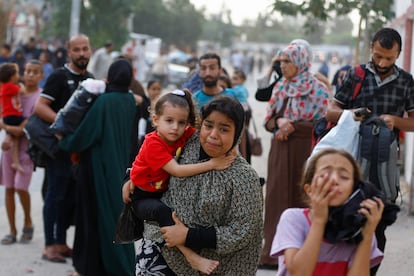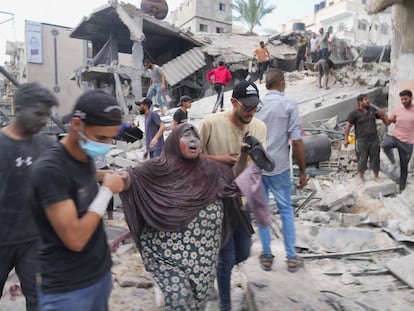Palestinians in Gaza experience largest exodus since the Nakba 75 years ago
One million civilians have been displaced from the north of the Strip following Israel’s ultimatum. This movement is reminiscent of the ‘catastrophe’ endured by the Palestinian people in the war that ensued the end of the British Mandate in 1948


The Nakba (“catastrophe” in Arabic) — with the keys to the homes abruptly abandoned 75 years ago, the processions of more than 700,000 refugees besieged by Israeli troops — is as integral, if not more so, to Palestinian identity than the Dome of the Rock on the Temple Mount in the Old City of Jerusalem. The forced displacement of hundreds of thousands of civilians from the northern Gaza Strip, in the wake of the ultimatum issued on October 13 by the Israeli army, has brought back to the Palestinians the memory of the debasement and uprooting catastrophe, in an exodus of biblical dimension that is still felt as a collective trauma.
The Palestinian historian Johnny Mansour warns: “The evacuation ordered by the army last week, under the pretext of protecting the safety of civilians from an intense war campaign, is an ethnic cleansing operation affecting hundreds of thousands of civilians.” Mansour resides in the city of Haifa (northern Israel), where the 1948 exodus was less significant than in other regions that were completely drained of their Arab population. “What is happening in Gaza is a second Nakba, the biggest since 1948 under the same plan. If the homes of the displaced are being destroyed now during heavy bombardment and in a military ground invasion, there will be no chance to return,” argues the 62-year-old university professor, an Israeli national and Palestinian nationalist activist, who specializes in the Middle East conflict.
On Thursday, the United Nations Office for the Coordination of Humanitarian Affairs (OCHA), raised the number of internally displaced persons in the Strip since the beginning of the current conflict on October 7 to one million civilians. More than 500,000 of them have sought refuge in facilities of the United Nations Relief and Works Agency for Palestine Refugees in the Near East (UNRWA), which has estimated that some 600,000 individuals have already crossed the Gaza Valley, the boundary south of the enclave’s capital established in the Israeli Defense Forces’ (IDF) ultimatum. Of these, 400,000 are currently packed into areas close to the border with Egypt. The U.N. previously declared the Palestinian enclave “uninhabitable” in 2020, but the war and the stringent blockade have further aggravated the situation.
“Not since independence in 1948 has there been a population displacement inside Israel over security issues on the scale of the one we are seeing now, with entire towns evacuated, such as Kiryat Shmona, near the Lebanese border, with more than 20,000 inhabitants,” explains Meir Margalit, a 71-year-old Israeli historian positioned on the pacifist left and a former head of Palestinian affairs at the Jerusalem City Council. “But that is nothing compared to the exodus that is occurring in Gaza. Here, there are only a few tens of thousands of evacuees, and if they don’t go home to relatives, they stay in hotels at the state’s expense.” Margalit speaks on the phone as he heads to the town of Ashkelon, one of the hardest hit by rockets fired from the Strip, to pick up personal belongings of his son, who evacuated the border area along with his family after the Hamas attack on October 7.

“In Gaza, there are now a million people practically homeless. This is a crime against humanity,” stresses this expert on the Palestinian situation, author of the book Jerusalem, the Impossible City. “In addition, this exodus is of no use to Israel, since it will not be able to eliminate Hamas forever and return control over the Gaza Strip to the Palestinian Authority,” he warns. “What Israel is planning is just part of a retaliation, something that always results in a vicious circle of violence.”
“In 1948 the Palestinian population was forcibly uprooted and then not allowed to return to their homes,” he continues. “The people of Gaza are supposed to return to their homes when the war is over, if Israel keeps its promise not to stay on Palestinian land, contrary to what it did 75 years ago. I don’t think this government is stupid enough to step into that quagmire: it would be a Vietnam for Israel.”
War crimes
The Prosecutor’s Office of the International Criminal Court (ICC), based in The Hague, launched a war crimes investigation in Palestine in 2021. The investigation targeted both Israel, for the mass bombardments in 2014 on the overpopulated Gaza, and Islamist militias, for indiscriminate rocket fire into residential areas in Israel, independent inquiries were in progress within the territorial enclave. “We are working among three fires: the Israeli occupation and blockade; the Palestinian Authority in the West Bank; and the Islamist Hamas movement in Gaza,” says Raji Sourani, director of the Palestinian Centre for Human Rights, a Gaza NGO, funded by international donations, whose mission is to document war crimes for the purpose of bringing them to the attention of international justice.
For Israel, the large-scale displacement of the Palestinian population in the 1948 Arab–Israeli War was the consequence of a conflict arising from attacks on the newly founded Jewish state by neighboring Arab countries, which refused to recognize the partition plan approved by the United Nations in 1947.
“The Nakba was a catastrophe for the Palestinian people, brought about by the offensive of the Haganah, the Zionist movement’s militia, which forced the exodus of some 750,000 refugees [more than half of the Palestinian population at the time] to neighboring countries. The lands and homes of the fleeing Palestinians were confiscated and over 500 villages were devastated. They lost everything,” Professor Mansour points out.
“But the exodus also took place, within historic Palestine under the British mandate, towards the West Bank and the Gaza Strip,” he explains. In the southern coastal enclave, between 70% and 80% of its 2.3 million inhabitants are refugees who have survived the Nakba or their descendants, mainly from the south of historic Palestine.
Remembering origins
Practically everyone in Gaza introduces themselves by pointing out where their family originated from in the present-day state of Israel. “I come from a village that disappeared between Ashdod and Ashkelon [on the coast, north of the Strip] that was called Hamama, which means ‘dove’,” explains Kayed Hamad, a 60-year-old translator who has worked with this newspaper’s correspondents for two decades. “I fear another Nakba. But I’m not going to move, I don’t want to repeat the same mistake my parents made in 1948. Wherever we go, Israel will pursue us,” he says via WhatsApp voice messages from Gaza’s capital.
Professor Mansour argues that “the Nakba is not just a historical event of 1948, but it is something that continues in many directions. This happening now in Gaza, but also with the discrimination we Palestinians suffer from Israel, with settler attacks on inhabitants of the West Bank.” The Strip has been in conflict for 75 years. In 1956 (Suez Canal crisis), in 1967 (when it was occupied by Israel), and in 1973 (Egyptian reconquest of the Sinai). After the departure of Israeli troops in 2005, it has endured five other wars to date.
Nearly two decades after the Nakba, another 115,000 Palestinians followed the same path of exile in the “Naksa” — meaning defeat or setback — in the so-called Six-Day War in 1967, when Israel militarily occupied the West Bank, Gaza and East Jerusalem. Today some seven million Palestinians still live within so-called historic Palestine: Israel and East Jerusalem (two million), the West Bank (close to three million) and the Gaza Strip (over two million), and another six million are abroad, mainly in the Middle East, of which some five million are registered by the UNRWA in neighboring countries.
Jewish historian Margalit reflects: “Now, Benjamin Netanyahu’s government is only seeking revenge, without evaluating the consequences of decisions such as the large-scale displacement of the population in Gaza. Being Jewish and enduring the Holocaust does not give us permission to do whatever we want.”
Palestinian historian Mansour brings Abdel Fattah el-Sisi into the equation: “The Egyptian president has told Israel that if it wants to offer a refuge to those displaced by this war, it should welcome them in the Israeli Negev territory instead of trying to send them to the Sinai Peninsula.” Cairo does not want a repeat of the travesty of the 2008-2009 war (Operation Cast Lead), when thousands of Gazans settled in Sinai after Hamas demolished part of the border fence.
With all borders sealed, Palestinians in Gaza cannot leave the Mediterranean territory. Many also do not want to return to areas that are being bombed. “What is happening in Gaza is genocide,” says Mansour. “With the overcrowding in the Strip, it is one bomb per person.”
Sign up for our weekly newsletter to get more English-language news coverage from EL PAÍS USA Edition
Tu suscripción se está usando en otro dispositivo
¿Quieres añadir otro usuario a tu suscripción?
Si continúas leyendo en este dispositivo, no se podrá leer en el otro.
FlechaTu suscripción se está usando en otro dispositivo y solo puedes acceder a EL PAÍS desde un dispositivo a la vez.
Si quieres compartir tu cuenta, cambia tu suscripción a la modalidad Premium, así podrás añadir otro usuario. Cada uno accederá con su propia cuenta de email, lo que os permitirá personalizar vuestra experiencia en EL PAÍS.
¿Tienes una suscripción de empresa? Accede aquí para contratar más cuentas.
En el caso de no saber quién está usando tu cuenta, te recomendamos cambiar tu contraseña aquí.
Si decides continuar compartiendo tu cuenta, este mensaje se mostrará en tu dispositivo y en el de la otra persona que está usando tu cuenta de forma indefinida, afectando a tu experiencia de lectura. Puedes consultar aquí los términos y condiciones de la suscripción digital.
More information
Archived In
Últimas noticias
Most viewed
- Reinhard Genzel, Nobel laureate in physics: ‘One-minute videos will never give you the truth’
- Oona Chaplin: ‘I told James Cameron that I was living in a treehouse and starting a permaculture project with a friend’
- Pablo Escobar’s hippos: A serious environmental problem, 40 years on
- Why we lost the habit of sleeping in two segments and how that changed our sense of time
- Chevy Chase, the beloved comedian who was a monster off camera: ‘Not everyone hated him, just the people who’ve worked with him’










































